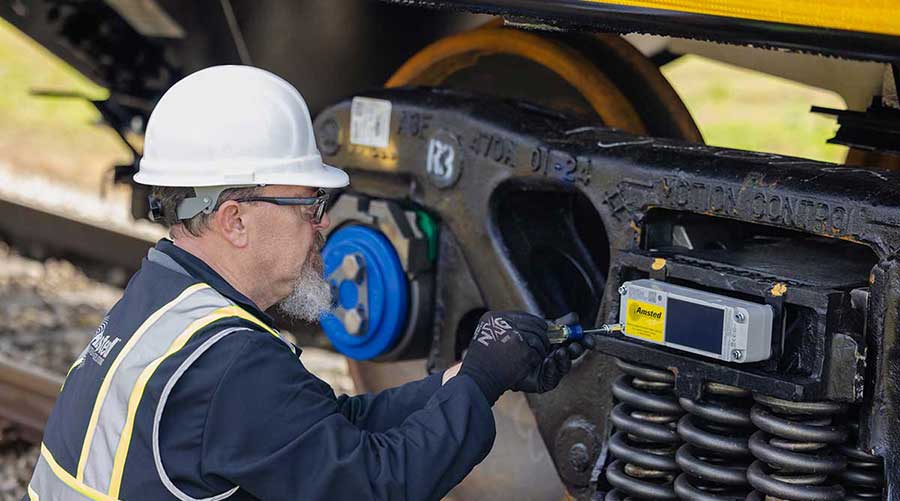Stay updated on news, articles and information for the rail industry
December 2010
Part 1 : Rail Outlook: 2011
Part 3 :
Class I Outlook: 'Year of Opportunity'
Part 4 : 'Certainty is what drives investment' — AAR's Ed Hamberger
Part 5 : Short-Line Outlook 2011
Passenger Rail Outlook 2011 - 'Still a Little Tenuous'
High-Speed Rail: In flux in 2011
Part 8 : Rail-Car Deliveries in 2011
Rail News: Rail Industry TrendsClass I Outlook: 'Year of Opportunity'
— by Jeff Stagl, Managing Editor
Heading into 2010, Class I chief executives anticipated an economic uptick and traffic upswing after a recession-restricted 2009. They got that and more.
"The economic recovery exceeded our initial expectations. Inventory re-stocking and government stimulus played significant roles in driving economic performance, particularly in the first half of the year," said CN President and Chief Executive Officer Claude Mongeau in an email.
But continuing economic strengthening in 2011 likely won't exceed the CEOs' current projection, which calls for a very gradual recovery, one that perhaps will take several years to play out.
"There will continue to be economic growth, but slow growth, slow as maybe 1 to 2 percent GDP," said Norfolk Southern Chairman, President and CEO Wick Moorman during an Oct. 4 interview. "And that will last a long while."
Compared with banner 2006 levels, U.S. rail volumes only are "about 60 to 65 percent back and the manufacturing sector is about 50 percent back," said BNSF Railway Co. Chairman and CEO Matt Rose in an email.
"The worst of the recession is behind us and we will see some growth, but not back to the levels we saw in 2006," he said.
The economy continues to be CEOs' No. 1 topic when sizing up the coming year. During interviews or in emailed responses to questions Progressive Railroading posed to all Class Is as part of our annual "outlook" coverage, the top execs expressed confidence that economic growth in 2011 would be strong enough to drive up traffic and revenue at least several percentage points.
"I would say we aren't extraordinarily bullish, but we are optimistic," as Moorman put it, citing favorable projections for agricultural products, coal and intermodal volume, but lingering skepticism about soft housing- and construction-related traffic.
Given the slow-but-steady forecast, the CEOs' charge is to figure out how to keep boosting their respective railroad's traffic and revenue vs. a relatively strong 2010 and amid lingering weakness in a few sectors, including forest and paper products.
"I believe in 2011 we will face a recovery punctuated with volatility," said Canadian Pacific President and CEO Fred Green in an email.
That unpredictability includes a number of intangibles that could hamper a Class I's growth strategy, such as a still-lagging job market, available capital for infrastructure improvements and rolling stock upgrades, obtainable federal funding for rail investments — which could hinge on surface transportation reauthorization efforts — and a continual resource drain and technology learning curve associated with positive train control (PTC) implementation.
A Chance to Shine
Despite a few potential hurdles to clear and snail-pace economic growth — both in North America and abroad — to endure, 2011 will be "a year of opportunity," CSX Corp. Chairman, President and CEO Michael Ward believes. Various manufacturing and consumer indices show an expanding manufacturing sector and below-normal inventories, "which suggest an ongoing need for safe, reliable rail services," he said in an email.
"That opportunity ... is already at hand as CSX is seeing volume growth in nearly all markets," said Ward.
For CP's Green, "challenge creates opportunity." The recession afforded the Class I a chance to rethink the railroad's business and the way it operates, he said. For example, CP plans to sharpen its focus on longer trains to boost safety, fuel efficiency and productivity, and reduce rail wear.
"Using our proprietary train marshalling software, we now have the capability of running 12,000-foot trains across the continent, and even some 14,000-foot transcontinental trains," said Green.
In addition to lengthening more trains, Union Pacific Railroad aims to employ more workers. If the economy continues to grow — despite an unemployment rate that continues to impact consumer confidence — UP plans to hire 3,500 to 4,000 workers next year vs. 1,700 in 2010, said Chairman, President and CEO Jim Young in an email.
Close Eye on Two Countries
Meanwhile, GDP growth in both the United States and Mexico present traffic- and revenue-boosting opportunities for Kansas City Southern, which operates railroads in both countries and manages an intermodal corridor that links the nations. Mexico's GDP growth is expected to outpace the United States' in 2011, as it will this year, said KCS President and CEO David Starling in an email.
The Institute for Supply Management's Purchasing Managers Index and industrial production rates in the United States and Mexico also are "trending positive," he said.
"We closely track our most economically sensitive commodity areas, such as chemicals, autos, steel and consumer products, [and] we are not seeing any underlying softness in any of these areas," said Starling.
CN's Mongeau keeps tabs on various economic indicators, too, including GDP, industrial production, trade, housing starts and vehicle sales.
"Most critically, we're keeping a 'close eye' on our customers, [who] have the best information about what is happening with their businesses and, in turn, what sort of volume outlook we can expect," he said.
Efforts this year to increase supply-chain collaboration and improve performance — such as scheduled grain service in western Canada and service-level agreements with Canadian intermodal terminal operators — have helped CN boost Canadian grain volumes to a level "not seen in 15 years" and set a nine-month record for overseas intermodal traffic, said Mongeau.
"Supply-chain innovation requires deeper customer engagement, which ... gives us greater intelligence about our customers' markets and their views on economic prospects," he said.
However, there are a number of shippers who have a different view on railroads' rates and rail competition, hence their decades-long attempt to pursue a regulation-change measure in Congress. The latest iteration — the Surface Transportation Board Reauthorization Act of 2009 (S. 2889) — gained a little steam in the Senate this year before the November elections changed control of Congress. Among its proposals, S. 2889 would require railroads to quote bottleneck and terminal switching rates, increase the STB's scrutiny of future railroad mergers and lower shippers' filing fees for a rate complaint.
The "drum beat" for regulatory reform will always sound, said NS' Moorman.
"It's an issue that's been out there for 20 years, so we'll obviously be continuing to talk about it," he said.
There is growing bipartisan appreciation of rail's benefits to the nation, and balanced regulation is consistent with the country's need to create jobs and rebuild the economy, said CSX's Ward.
Capital Investments 'At Risk'
UP's Young believes rail can continue to play an important role in the nation's "serious infrastructure problem" by infusing billions of dollars of private capital into infrastructure upgrades.
"Getting it wrong when it comes to additional regulations or new legislation could have a negative impact on future investments," he said. "When you think of the most important problems facing our country, I have a hard time seeing where issues involving railroad regulation would be near the top of the list."
Railroads' investments during the past 30 years depended upon "reasonable earnings and a constructive regulatory environment," said BNSF's Rose.
"Without that, the billions of dollars of capital that the railroads have invested are at risk, and so is the fluidity of our nation's supply chain," he said.
Some expected membership changes to the Senate Commerce Committee — which drove S. 2889 — and House Transportation and Infrastructure Committee could impact regulation-reform efforts next year, said CP's Green.
CP and CN also plan to remain involved in regulation-change activities in Canada. In October, a federal Rail Service Review Panel released an initial report, which stated some rail services are less than adequate and that regulatory solutions should be implemented in 2013 if recommended initiatives don't improve rail service. A final report is expected in early 2011.
"Increased rail regulation would have the unintended consequences of increasing costs, stifling innovation and potentially discouraging investments," said CN's Mongeau.
However, Class I CEOs wouldn't mind some regulatory relief when it comes to PTC implementation, such as an extension of the mandated Dec. 31, 2015, deadline or an allocation of more federal funds. Absent that, CSX is trying to find ways to accelerate suppliers' development of various hardware and software components.
"Some project challenges include establishing a nationwide private radio network to provide communications pathways," said Ward.
UP has encountered design work and material availability delays, said Young. Next year, UP plans to spend about $250 million, and conduct pilot programs in the southern Power River Basin and Spokane Subdivision.
BNSF's 2011 plans include continuing PTC testing/implementation work in several subdivisions. However, money spent on PTC next year will "crowd out other investments," said Rose.
"As an industry, we'll spend $9 billion this year, except $700 million of that will be [spent] on the first steps of PTC implementation," he said. "What will fall out of the budget when the PTC spend is even higher for the industry in 2011?"
Next year, CN plans to complete a corporate telecommunications backbone along mainlines, complete field installation work in a pilot territory west of Chicago and continue installing onboard systems in locomotives.
CP will spend 2011 testing and proving its PTC technology, said Green. The Class I has established an indoor/outdoor lab facility in Calgary, Alberta, where workers will assess CP's PTC solution through the first quarter, he said. By summer, the Class I also plans to complete wayside installations and launch tests in an Iowa pilot subdivision.
Meanwhile, KCS will complete a GPS survey of track infrastructure and deploy a track database, said Starling.
"There will need to be some discussion about ways for the industry to test the implementation of this technology on a pilot basis and prove the most effective [one] before committing to unproven technology on a nationwide basis," he said.
Top-of-Mind Matters
A number of other festering issues will need to be discussed among various constituents next year, as well. Among them: the case for a 25 percent freight-rail infrastructure tax credit, the implications of a surface transportation reauthorization measure and the ramifications of additional carbon emission regulations under the Clean Air Act.
"We need to avoid market-distorting tax policy, [such as] a taxpayer bailout of the Highway Trust Fund that would equate to subsidization of heavy trucks," said Rose.
The CEOs plan to continue touting rail's environmental friendliness and role in the nation's economy when stating the industry's case with politicians or government leaders. The case continues to draw more attentive ears, they say.
"Thanks to the increasing emphasis on reducing our dependence on oil and improving our environment, economic growth and easing highway congestion, railroads have become relevant again in the public eye," said Ward.
For Young, the watchwords are "agility" and "adaptability" when it comes to maintaining UP's focus on improving safety, service and productivity in the face of economic, regulatory and political uncertainty. His Class I counterparts probably would agree.
"We must continue to innovate in terms of new [service] products and not lose sight of the fact that reduced variability and increased resiliency equate to more reliable service," said Young. "We will continue to place a high priority on technology, lean techniques and asset utilization to assure that a safe and reliable railroad is also an efficient one."
Keywords
Browse articles on outlook 2011 rail outlook Class I BNSF Union Pacific Norfolk Southern CSX CN Canadian Pacific Kansas City Southern KCSContact Progressive Railroading editorial staff.


 2025 MOW Spending Report: Passenger-rail programs
2025 MOW Spending Report: Passenger-rail programs
 Gardner steps down as Amtrak CEO
Gardner steps down as Amtrak CEO
 Guest comment: Oliver Wyman’s David Hunt
Guest comment: Oliver Wyman’s David Hunt
 Women of Influence in Rail eBook
Women of Influence in Rail eBook
 railPrime
railPrime






